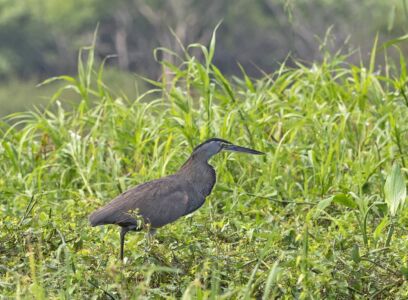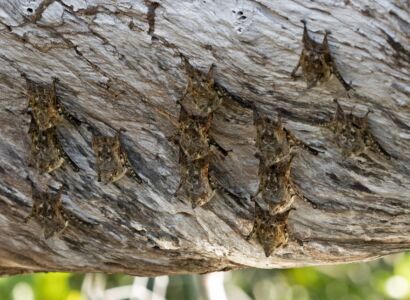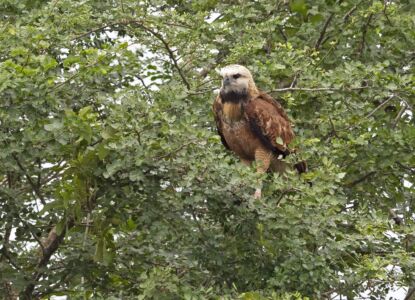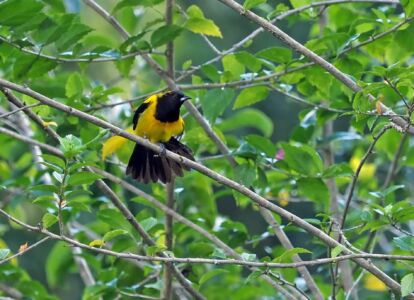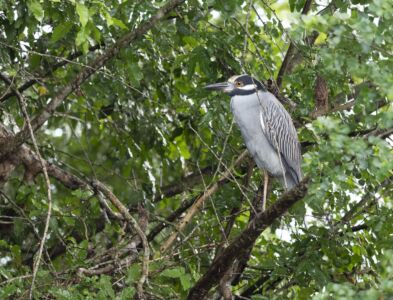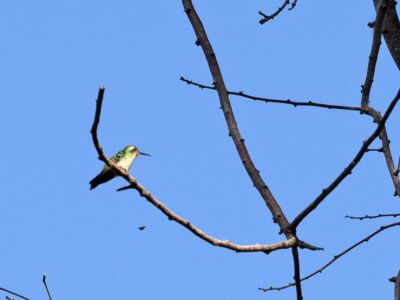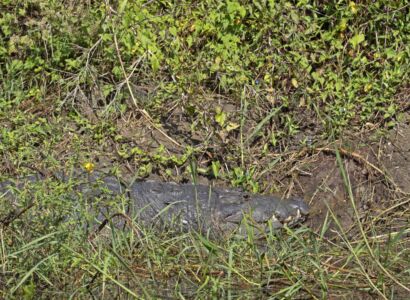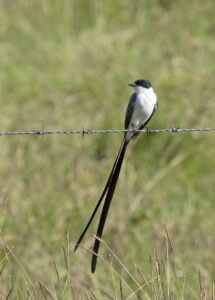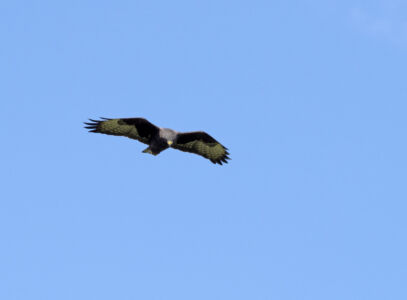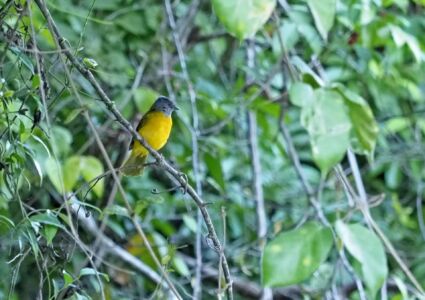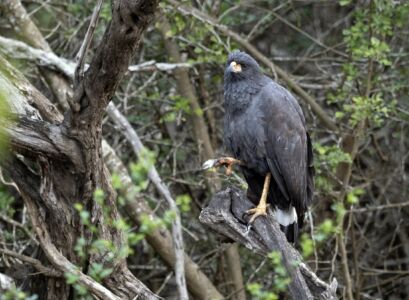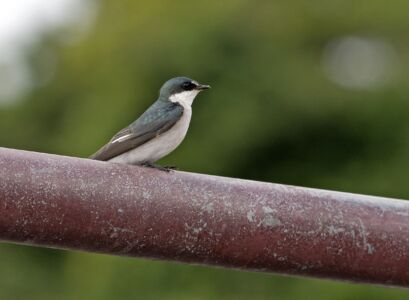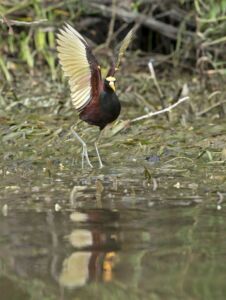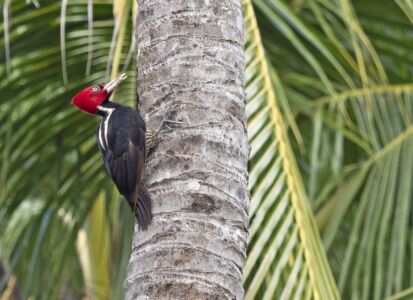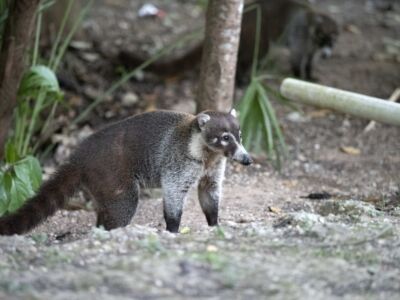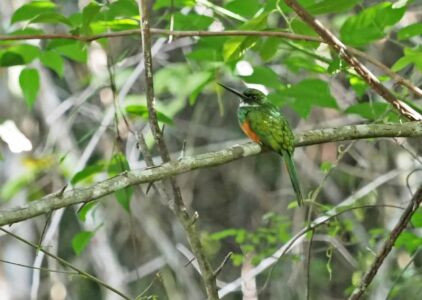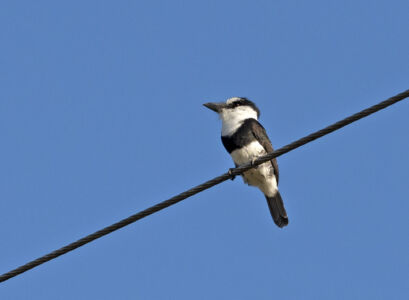TRIP REPORT: BELIZE – 2019 December – Northern Forests & Wetlands

TOUR FOCUS
TRIP LEADERS
PRIVATE TOUR OPTION
This tour is available as a private trip for any size group. The tour cost will vary with the number of people and any custom requests.
TESTIMONIALS
Trip report by Sally Ingraham
When you step out of the airport into the warmth and color of Belize, it is best to leave all prior expectations behind (along with the winter coat you won’t be needing again!)
Maybe you’ve traveled and birded extensively in Central America already, or perhaps you’re embarking on your first trip to the tropics. Either way, Belize will surprise and fascinate you.
For the folks on this tour, Belize served up a rich variety of experiences over the course of eight days. Three unique regions, Mayan ruins, riverboat adventures, delicious Caribbean food, and comfortable lodges were the backbone of a birding trip that surpassed all expectations.
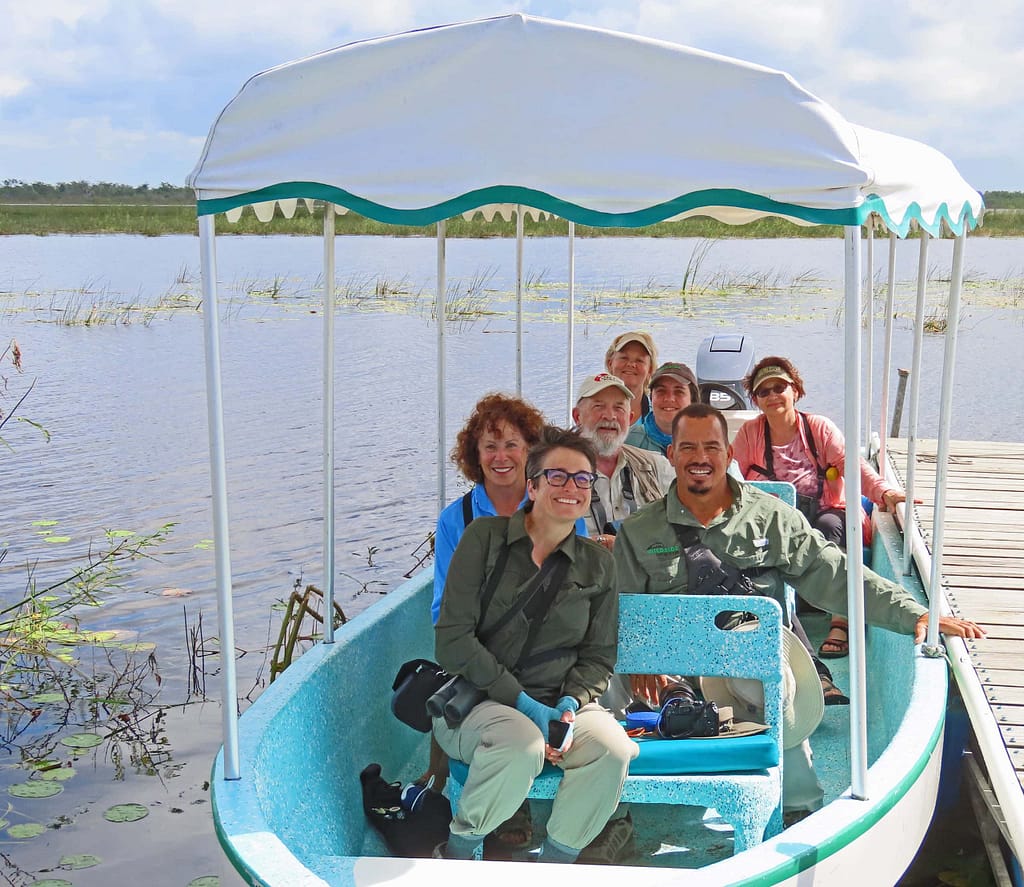
The Wildside Nature Tours Belize December 2019 group, ready to explore Crooked Tree lagoon – front to back: Rebecca, Duffy and Glenn, Mark, me, Mary and Donna – photograph by Rudy Crawford
With the guidance of Glenn Crawford we found over 250 species of birds, and saw a dozen types of mammals. Interesting reptiles and insects and plants were abundant. The tour was truly a crash course in tropical ecology.
Everyone went home – reluctantly, of course – but satisfied, inspired, and with a deeper sense of connection to the wonders the world will offer when you venture into the Wildside.
Read on for notes on the places we went and the birds we saw during this exciting trip!
Ladyville/Caribbean Shrimp Company
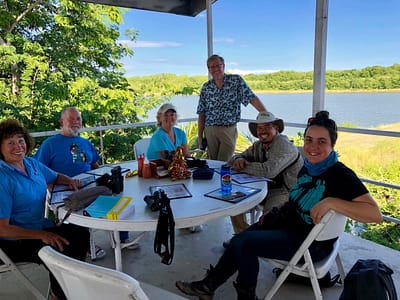
Some of our group at Capt. Hook’s Restaurant, along with the owner of the Caribbean Shrimp Company (standing) – photograph by Donna Lemke
All but one of our group had arrived in Belize by lunchtime on the first day. While we waited for our last participant, Glenn kicked off the trip in spectacular fashion.
We drove around the corner from the airport to the town of Ladywalk, and ventured out to Captain Hook’s Restaurant. This establishment is at the center of the Caribbean Shrimp Company, the only organic shrimp company in Belize – and a terrific birding spot too!
While enjoying fresh (pond-to-plate) shrimp dishes and getting to know one another, we watched many of our familiar North American birds enjoying the bounty of a recently drained pond. Stilt, Least, and Western Sandpiper, American Avocet, Willet, and Wood Stork wandered among Yellow-crowned Night-Heron, and Black-bellied and Semipalmated Plover.
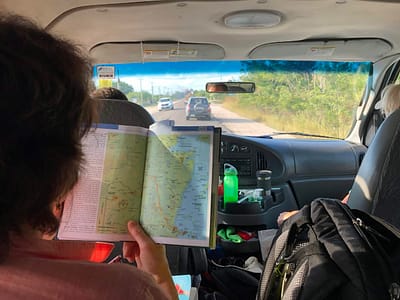
The route and road ahead – photograph by Sally Ingraham
There were new birds too for most of the group – a Lesser Yellow-headed Vulture circled above, and the jackhammer call of a Ringed Kingfisher startled everyone. Ruddy Ground Doves were nesting above the table where we ate – an adult feeding 3 young while we finished up our own meal.
By late afternoon we had collected our final participant and set off on a road trip that would take us across Belize, north and west, to the vast conservation area of Rio Bravo and the beautiful La Milpa Ecolodge.
Arriving after dark we could only imagine what the next days held, as far as wildlife went.
There were no doubts about the comfort of the cabanas, the deliciousness of dinner, or the need for sleep after a long day.
In fact, most of the group slept too well to hear the Yucatan Black Howler Monkeys giving us an official welcome to Belize. I woke to the sound of their howls and knew for certain that I was once again in the tropics!
La Milpa Ecolodge & Research Center/Rio Bravo Conservation Area
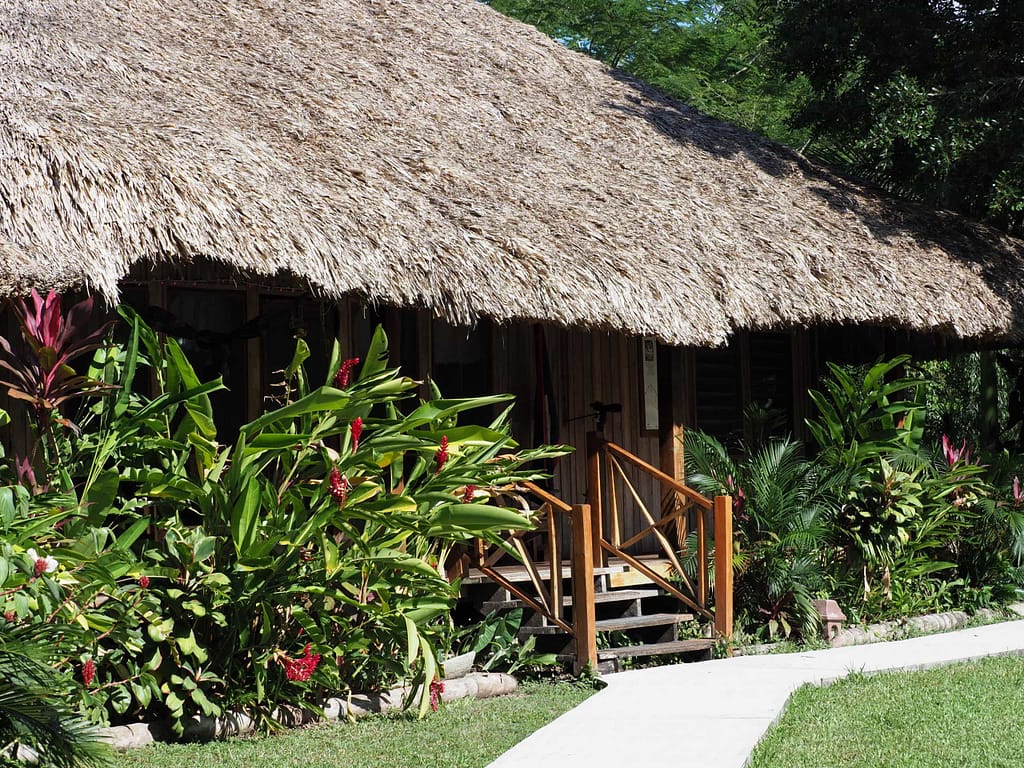
La Milpa Ecolodge – photograph by Glenn Crawford, using the Olympus E-M1 Mark II
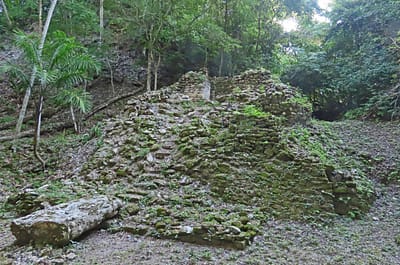
Some of the Mayan ruins at La Milpa Archeological Site – photograph by Mark Amershek
We spent three nights at La Milpa, and what felt like numerous days exploring this part of the Rio Bravo Conservation Area.
Rio Bravo consists of 260,000 acres of forested land in north-western Belize. It has been managed by The Programme for Belize since 1988. Much of the land is protected as a reserve for biodiversity. There are also numerous archeological sites where research into the Mayan civilization is ongoing.
The La Milpa Ecolodge provides a perfect taste of all that Rio Bravo conserves, with a Mayan ruin just three miles away and expansive forests on all sides.
We started each morning drinking coffee underneath a fruiting fig tree, completely overwhelmed by the quantity of birds feasting above us. There would be Olive-backed and Yellow-throated Euphonia, and Red-legged and Green Honeycreepers moving about. Red-capped Manakins jostled for space with numerous familiar, but no less delightful, warbler species.

White-bellied Emerald – photograph by Glenn Crawford, using the Olympus E-M1 Mark II
Hummingbirds zipped from the feeders on the porch to the tree branches – Wedge-tailed Sabrewing, White-bellied Emerald, and Rufous-tailed Hummingbird occasionally duking it out. Social and Boat-billed Flycatchers shouted from the tree top, while Spot-breasted Wren were heard calling constantly.
Special guests turned up each morning – sometimes a White-crowned Parrot showing nicely, or a crew of six Collared Aracari. Black-cowled Oriole or Gartered Trogon or Chestnut-colored Woodpecker would set off a chorus of camera clicks.
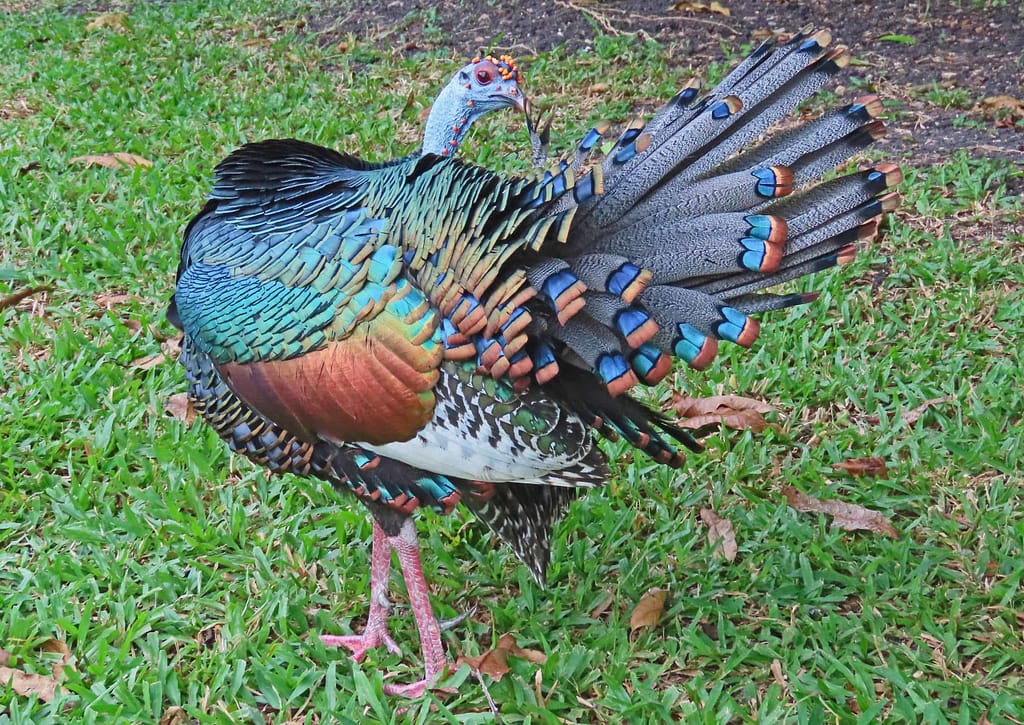
Ocellated Turkey preening – photograph by Mark Amershek
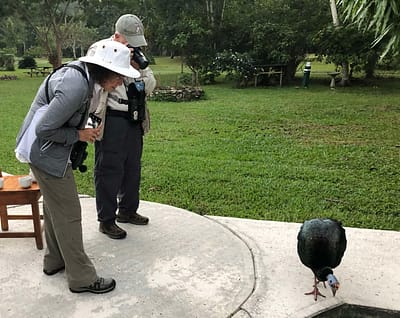
Daily photoshoot with our Ocellated Turkey friend at La Milpa – photograph by Sally Ingraham
There was always an Ocellated Turkey around, comfortably lingering nearby and usually following us if we ventured down the road in pursuit of other birds.
(This turkey was on the short list of life birds one participant anticipated seeing in Belize, as he had traveled extensively in Central and South America already. However, Mark never guessed that he would be on first name basis with “Turkey Tom”, and able to get portraits of a life bird from a distance of three feet…!)
Leaving the fig tree behind for the moment, we would direct our steps to the main road into the reserve, or down the road that leads to the La Milpa Archaeological Site.
These roads provided endless quantities of birds, if you had the ears to listen and the eyes to seek. Fortunately for us, Glenn Crawford has the best eyes and ears in Belize!
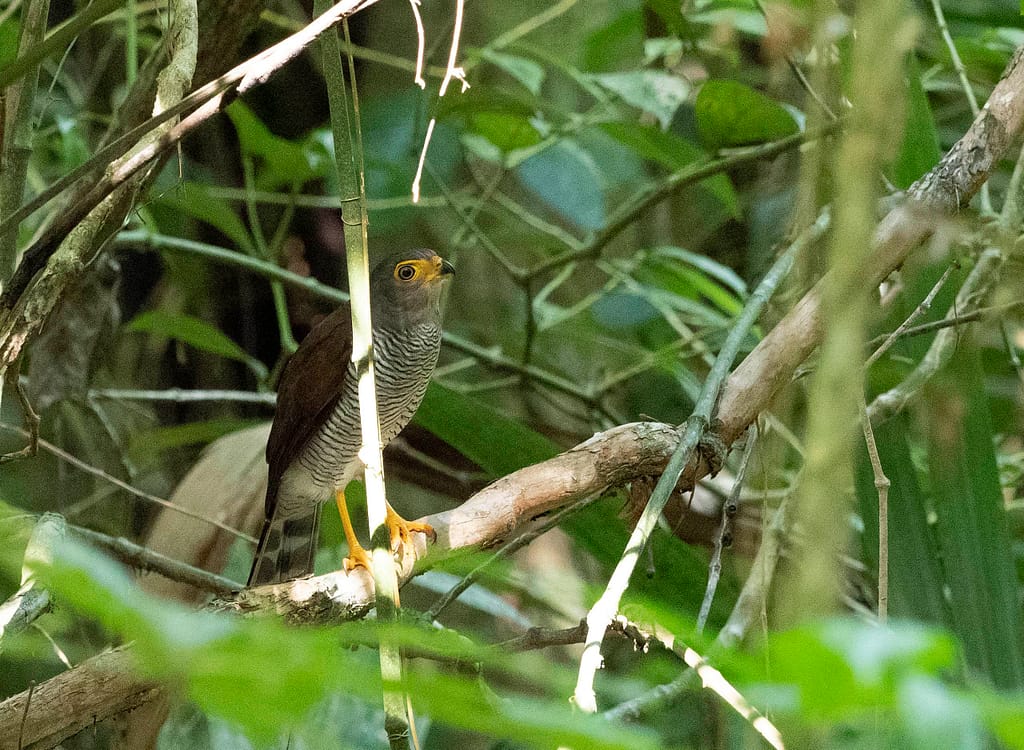
Barred Forest-Falcon – photograph by Glenn Crawford, using the Olympus E-M1 Mark II
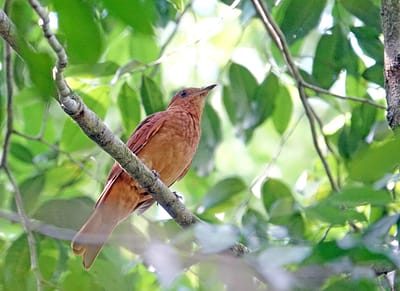
Rufous Piha – photograph by Sally Ingraham
A “typical” venture down the road would turn up 30-40 species. Multiple types of woodcreepers and ant-tanagers and wrens and flycatchers; fascinating birds like Plain Xenops and Eye-ringed Flatbill and Rufous Piha; wondrous singers like the Northern Schiffornis; frequent Roadside Hawks, and rare sightings of Barred Forest-Falcon.
Rufous-tailed Jacamar teased us from the shadows before coming out in pairs to show off. White-necked Puffbird and Squirrel Cuckoo were rivals for our attention.
The sky above the road could have a King Vulture floating across it, or a Short-tailed Hawk. If we were quick enough to notice, the road ahead might reveal a couple of Great Curassow or a Great Tinamou making a dash for it.
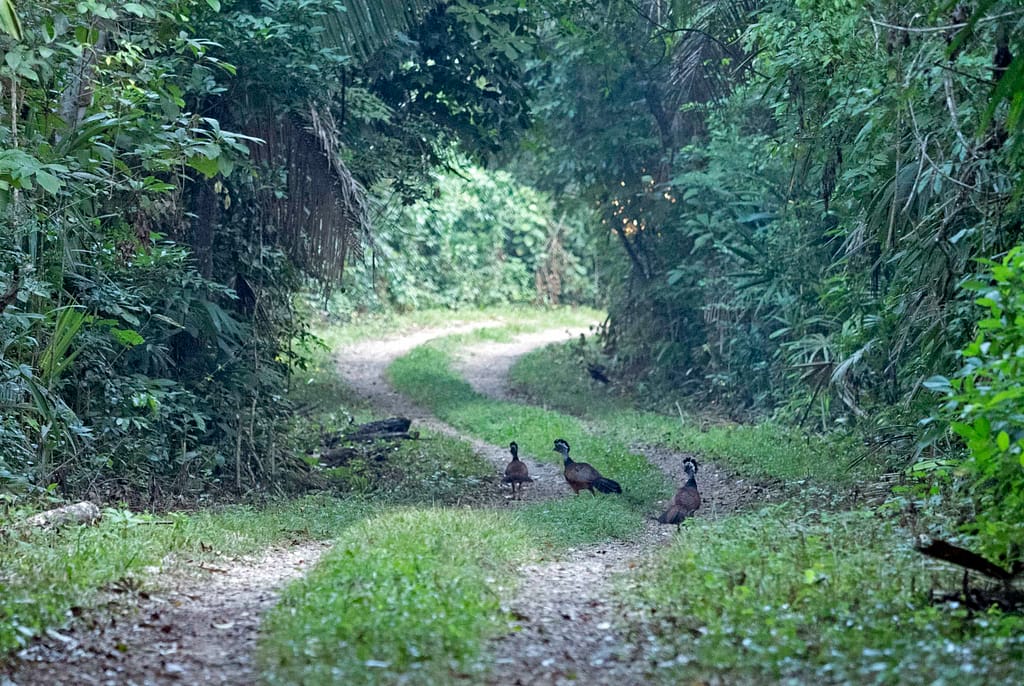
Female Great Curassow crossing the road to La Milpa ruins – photograph by Glenn Crawford (through the windshield of the van), using the Olympus E-M1 Mark II

Hiking to the La Milpa ruins – photograph by Sally Ingraham
The La Milpa ruins held their own fascination. We encountered White-lipped Peccary there, their presence betrayed to Glenn not by sight or sound this time, but by smell!
We heard Spotted Wood-Quail as we hiked up the trail to the ruins, although we never saw them (similar to the Lesson’s Motmot, which we heard in multiple places but never laid eyes on).
Pale-billed Woodpeckers were building a nest in trees that grew on piled rocks which were once Mayan dwellings. Mealy Parrots filled the forest with a cacophony of sound, joined by the occasional Bright-rumped Attila. Golden-crowned Warbler was the first warbler that most of us had never seen before.
A night drive revealed Northern Potoo on fenceposts, and Common Pauraque on the side of the road, and a few of us were lucky enough to hear Ferruginous Pygmy-Owl as we came for coffee the last morning, just before the sun rose.
All in all, La Milpa proved to be so extraordinary that we could have all gone home right then, and been happy. Of course, there was plenty more to see before we left Belize!

Duffy, me, Glenn, Rebecca, Donna, and Mary – plus Turkey Tom! – at La Milpa – photograph by Mark Amershek
Shipyard
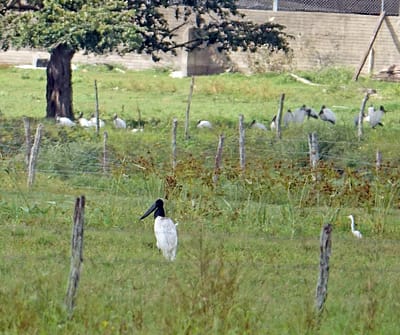
Jabiru, with Cattle Egret and Wood Storks – photograph by Sally Ingraham
The road trip continued as we traveled east and north this time – all the way north, to Shipstern Nature Reserve. Although this was a long travel day, it was much improved by a spin through the Mennonite community of Shipyard, where Glenn managed to find us a Jabiru – a life bird for all but him.
Even at a long distance, this huge stork of the tropical lowlands is unmistakable. We were grateful for this side trip, as Jabiru were nowhere to be found later on in our trip.
This is a perfect example of why a small group size is preferable – quick changes to the itinerary in order to see target birds are so much easier with a small, flexible, and enthusiastic group.
Along the road on this travel day we also had great looks at Laughing Falcon, Gray Hawk, and Fork-tailed Flycatcher.
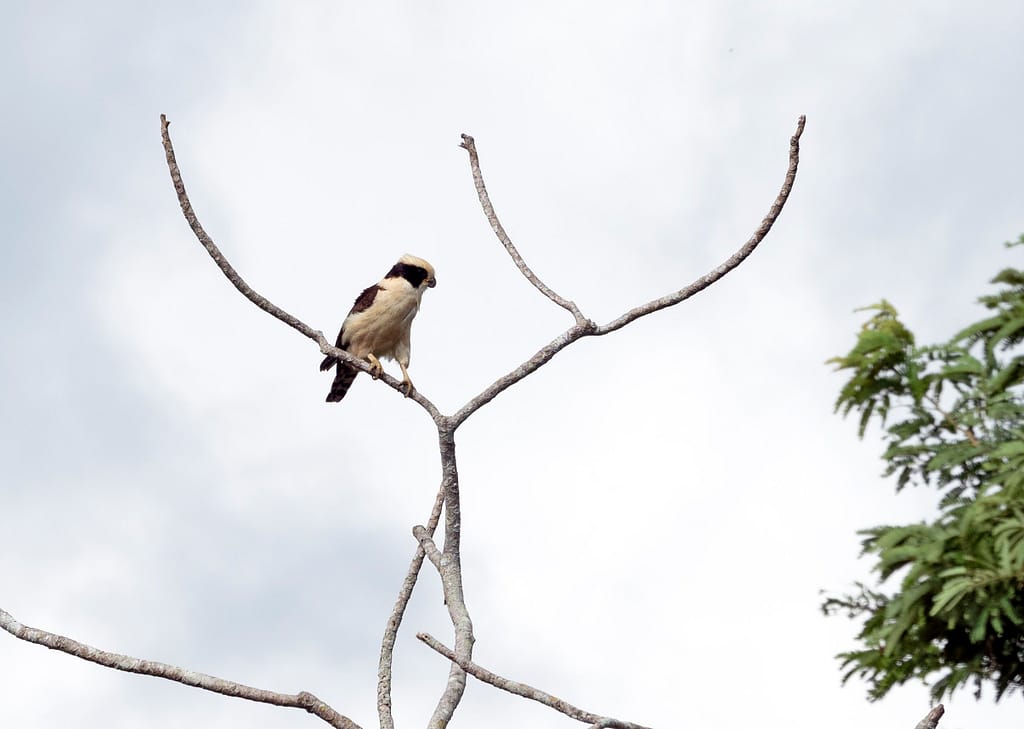
Laughing Falcon – photograph by Glenn Crawford, using the Olympus E-M1 Mark II
Shipstern Nature Reserve
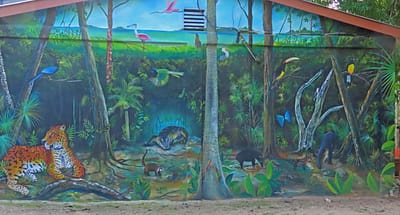
Mural on the side of a building at the Shipstern lodge – photograph by Mark Amershek
Shipstern and the neighboring coastal village of Sarteneja is in the remote northeastern part of Belize, accessible only via a long bumpy road. This isolation, and it’s proximity to Mexico, makes for a wonderful birding destination. Many Yucatan specialties can be found here, and almost 300 species of birds have been reported in the small area.
Brand new lodge facilities welcomed us upon our arrival. A late lunch and a nap in comfortable rooms quickly revived us. We were only spending one night here, so a late afternoon walk and a morning of exploration were made the most of.
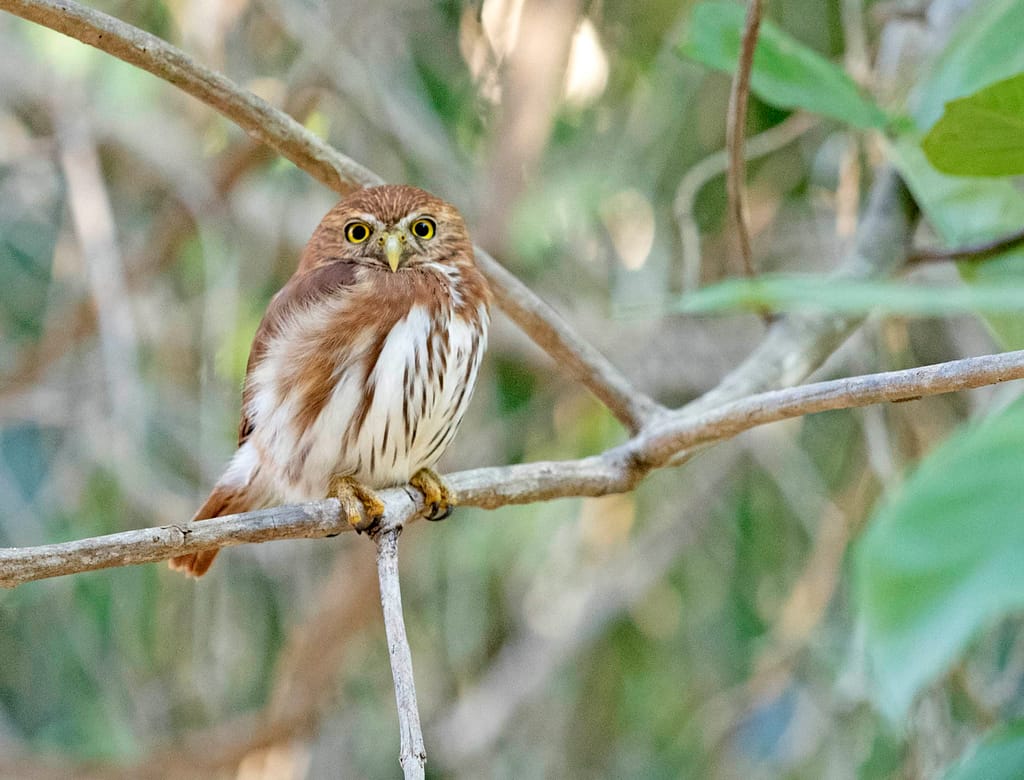
Ferruginous Pygmy-Owl – photograph by Glenn Crawford, using the Olympus E-M1 Mark II
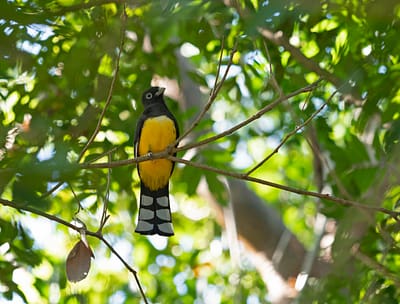
Black-headed Trogon – photograph by Glenn Crawford, using the Olympus E-M1 Mark II
We added dozens of new birds to our list at Shipstern, while getting better acquainted with many of the birds we’d discovered at La Milpa.
Truly stunning views of a pair of Ferruginous Pygmy-Owls right on the grounds of the lodge started things off well, although a Black-headed Trogon was equally cooperative and photogenic. There were Rose-throated Becard, Yucatan Woodpecker, and Golden-olive Woodpecker to be found around the grounds as well.
Our afternoon walk up the road revealed Yucatan Jays aplenty, loads of Altamira Oriole, Canivet’s Emerald, Red-billed Pigeon, and both Hook-billed and Gray-headed Kites. Yellow-lored Parrots flew above us regularly.
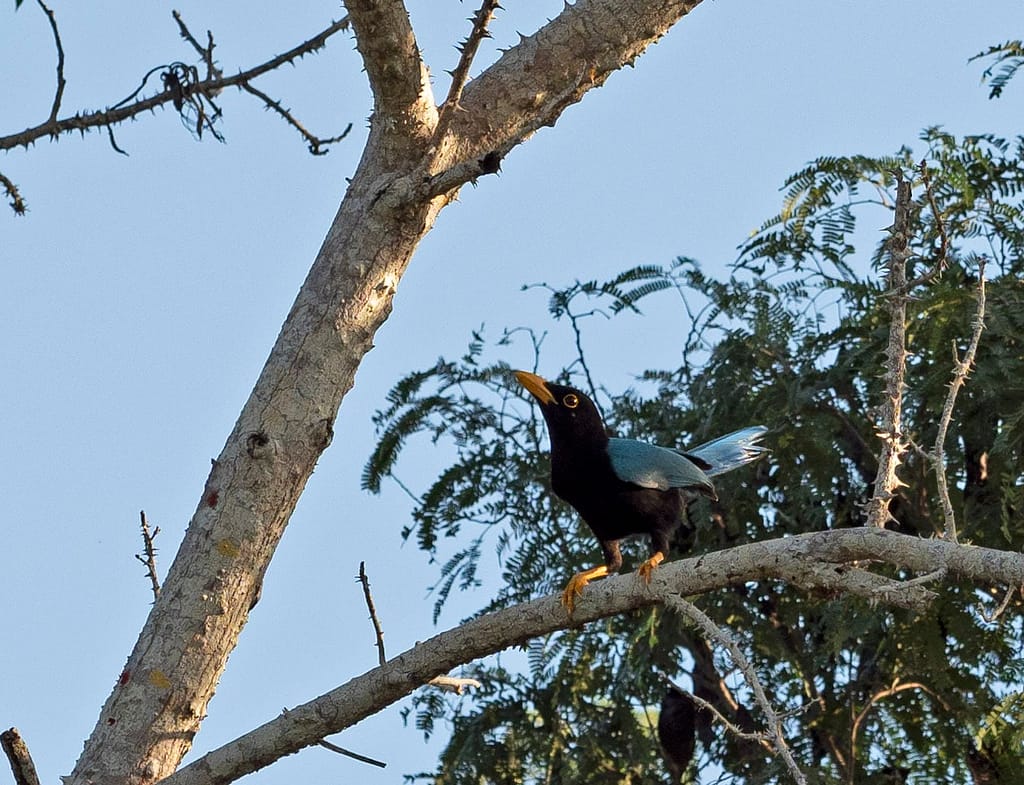
Yucatan Jay – photograph by Glenn Crawford, using the Olympus E-M1 Mark II
A night drive offered us an informative and fantastic listening experience, sorting through vocalizing toads to find the subtle call of the Middle American Screech-Owl, and Yucatan Nightjar. We even managed to see the Middle American Screech-Owl briefly.
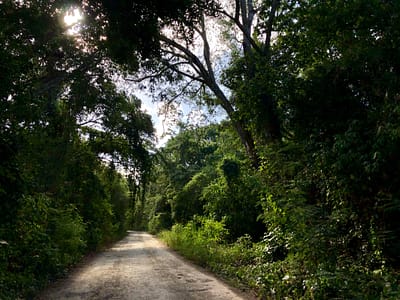
Sarteneja village lane – photography by Sally Ingraham
Our morning foray into the village of Sarteneja turned up even more new species. Some of our group had already sailed past 100 life birds at this point, and even Mark, the most well-traveled among us, had seen a half dozen (far more than he had predicted going into the trip!)
A shaded lane in the village offered respite from the heat of the morning, and the opportunity to see Yucatan Flycatcher, and hear the beautiful song of the Caribbean Dove.
We visited the coast briefly, soaking up sea breezes and adding some gulls and terns and Magnificent Frigatebird to our bounty.
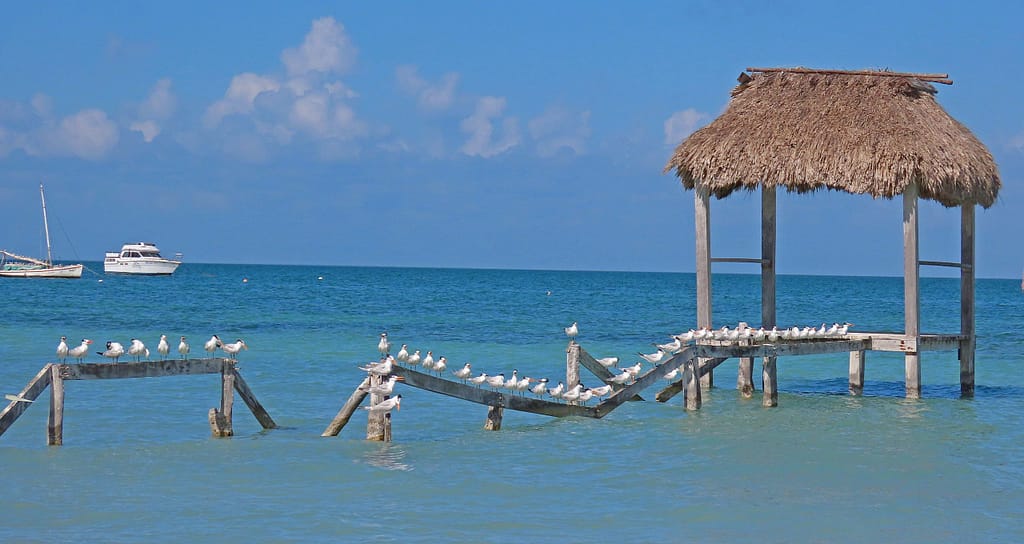
Sandwich and Royal Terns – photograph by Mark Amershek
Back on the road again we napped as Glenn drove south. Once we passed through Orange Walk Town, however, the group perked up. There was a sense of eager anticipation, for we knew we were headed home – to Glenn’s home, that is – the world-famous Crooked Tree.
Crooked Tree Wildlife Sanctuary
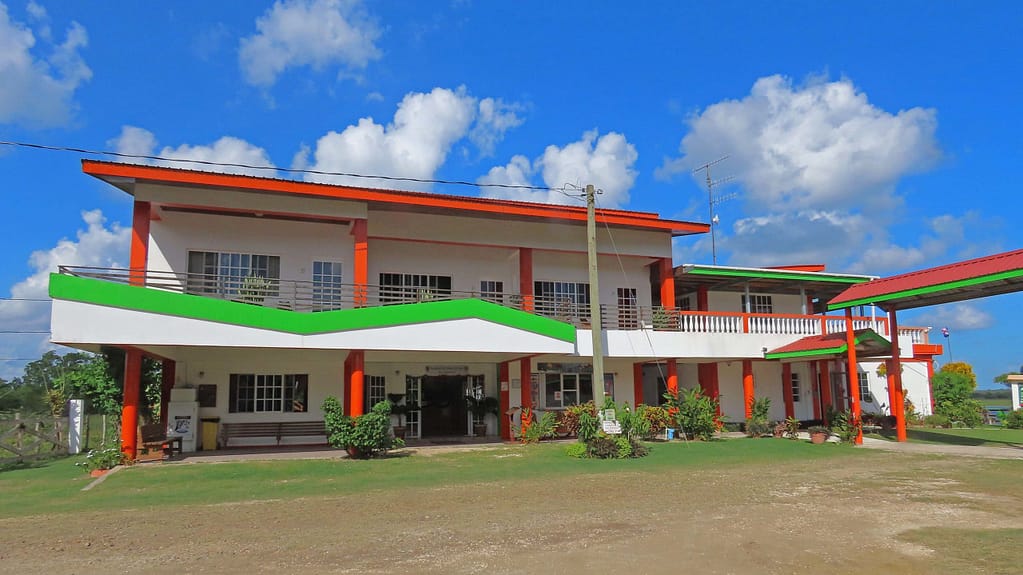
Bird’s Eye View Lodge – photograph by Mark Amershek
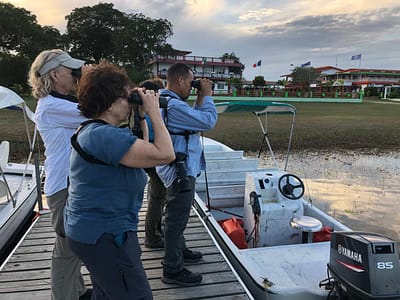
The group with Glenn – photograph by Sally Ingraham
We rushed through checkin at the beautiful Bird’s Eye View Lodge in Crooked Tree Village. The whole group of us were eager to see the lagoon. We soon turned up on the dock, with Glenn there too, just as pleased to show off the lagoon as we were to see it.
Crooked Tree Village has been on the island at the center of the lagoon since 1750. It is home to about 1,000 residents, a thriving cashew industry, lots of traditional Kriol culture, and Glenn’s family going back 4 generations.
Crooked Tree Wildlife Sanctuary is 36,479 acres of wetlands, savannas, lagoons and creeks – critically important habitat for migratory and local bird species. It was established as a protected area in 1984. Around 330 species of birds have been recorded in the area, including almost 40 different waterbirds.
That first evening, as Glenn had promised there were Vermillion Flycatchers everywhere, and numerous Ringed Kingfishers, making an absolute racket. The lagoon was loaded with Northern Jacana and every type of heron and egret.
Hundreds of Neotropic Cormorants flew by as the sun started to set, and Snail Kites skimmed across the surface of the water catching their dinner. A Crane Hawk leapt into the air from nearby bushes, and the moon rose magnificent and full over Crooked Tree.
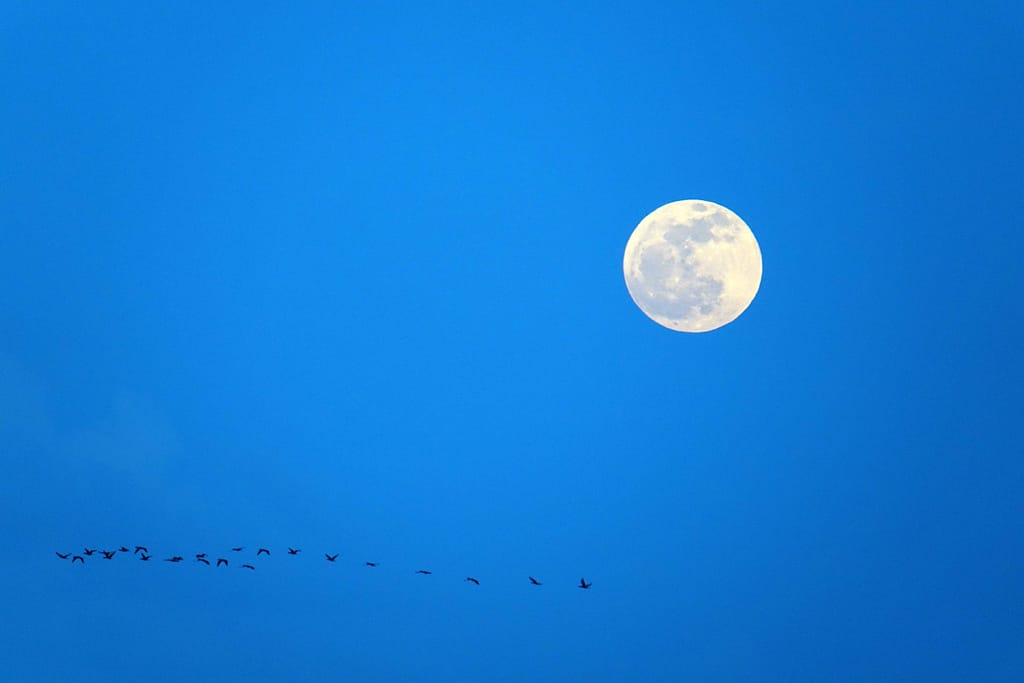
Full moon with Neotropic Cormorants – photograph by Sally Ingraham
After a delicious dinner at the lodge we went back down to the lagoon in the dark, in search of Boat-billed Heron, which come out to hunt at night. Glenn quickly found one. We had to tiptoe around Common Pauraque, which were scattered liberally over the lawn, in order to get closer to it! A Limpkin was heard, and we found a Wilson’s Snipe hanging out among the Pauraque too.
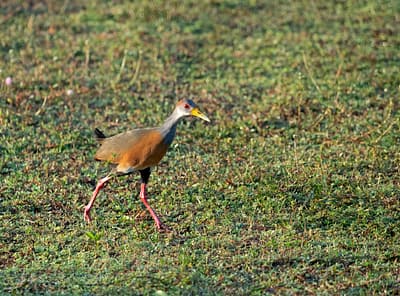
Russet-napped Wood-Rail – photograph by Glenn Crawford, using the Olympus E-M1 Mark II
Each day of the tour so far we had racked up a good species count, averaging around 75 species per day. Our last two days blew those other lists out of the water.
Our first morning in Crooked Tree, with Glenn’s expert skills and lifetime of experience in this area to aid us, we discovered 50 species of birds before breakfast! (And during breakfast we were visited by a Russet-naped Wood-Rail!)
A casual walk up the road from the lodge, towards the village center, brought us much anticipated views of Bat Falcon, and excellent looks at Common Tody-Flycatcher, Rufous-browed Peppershrike, and Grayish Saltator, plus numerous warblers and orioles.
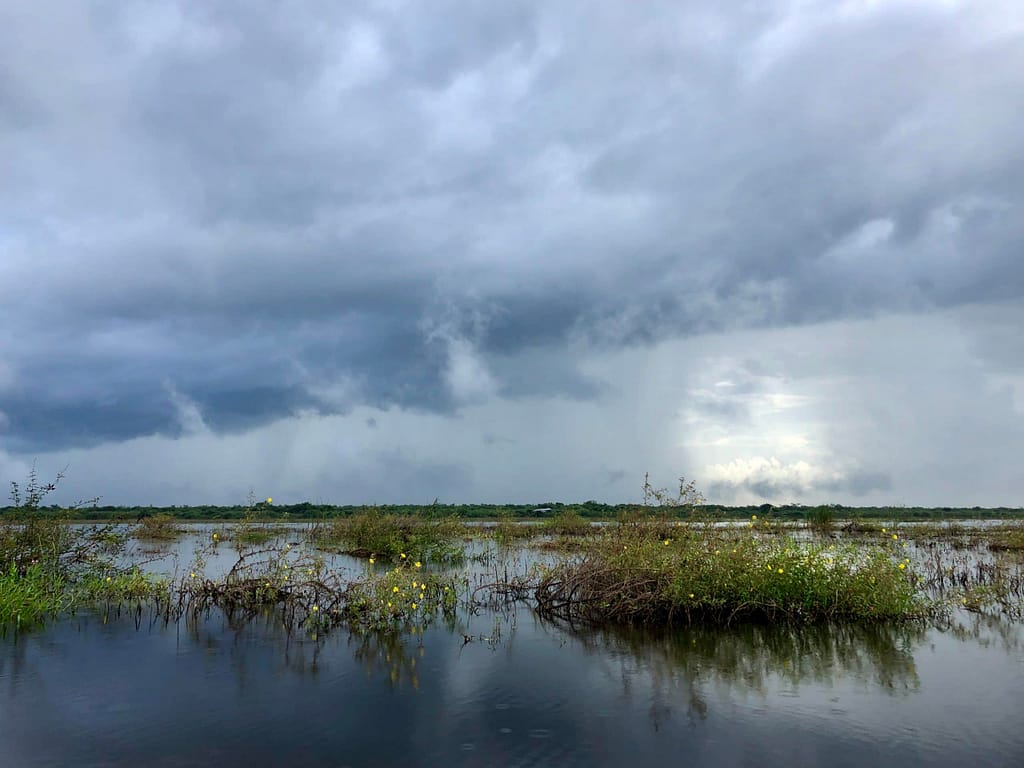
Crooked Tree Lagoon – photograph by Sally Ingraham

The group on the lagoon – photograph by Sally Ingraham
The highlight of the trip for most of us came after breakfast that day, when we explored the lagoon with Glenn and his brother Rudy. It was a long, leisurely boat ride with Rudy as captain, and with so many birds to see that we hardly knew where to look first.
While still comprehending an Aplomado Falcon, Glenn would turn our attention toward a Mangrove Vireo, then a Gray-throated Chat.
Boat-billed Heron were peeking out at us from the mangroves while we attempted to get photos of a Great Black Hawk, which finally flew – right past a Black-collared Hawk!
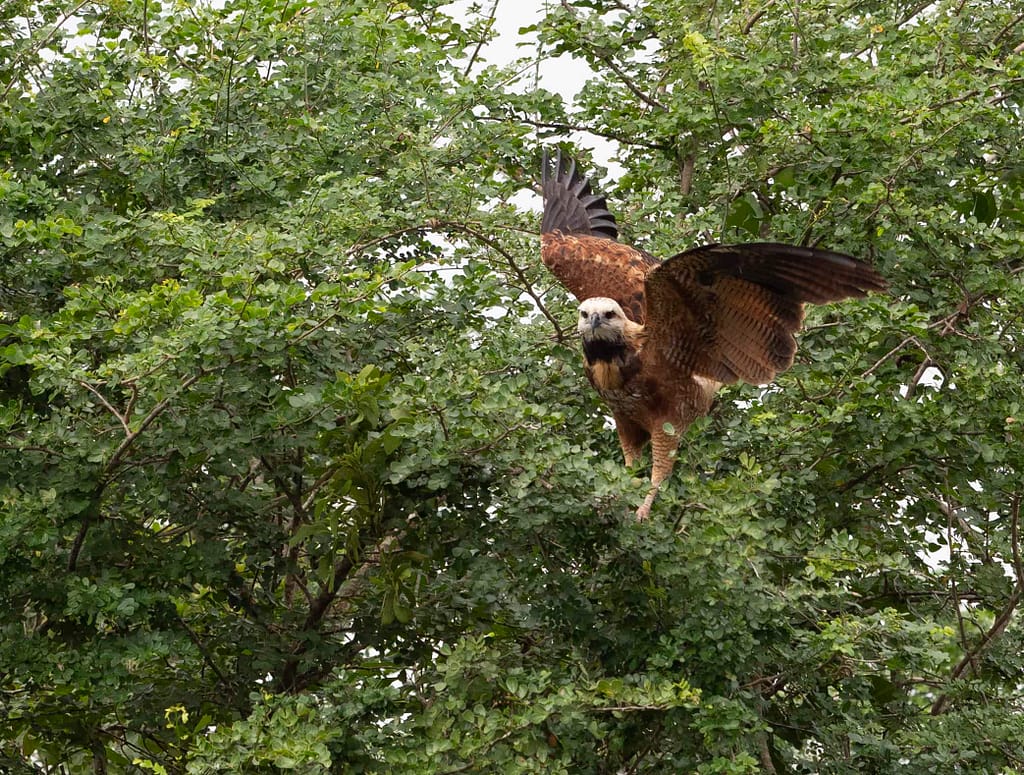
Black-collared Hawk – photograph by Glenn Crawford, using the Olympus E-M1 Mark II
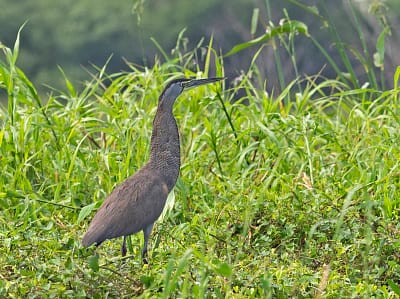
Bare-throated Tiger-Heron – photograph by Glenn Crawford, using the Olympus E-M1 Mark II
As we pressed into Spanish Creek we found our Bare-throated Tiger-Heron at last, more Black-collared Hawks, Yellow-tailed Oriole, and an enormous old Crocodile bigger than a cow…!
No one wanted that boat ride to ever end, but there was birding in other places to get to.
The afternoon was spent in the tangled vegetation at the edge of the lagoon, searching for (and finding of course, with Glenn Crawford at our side) Rufous-breasted Spinetail, Barred Antshrike, Black Catbird, and Yellow-billed Cacique.
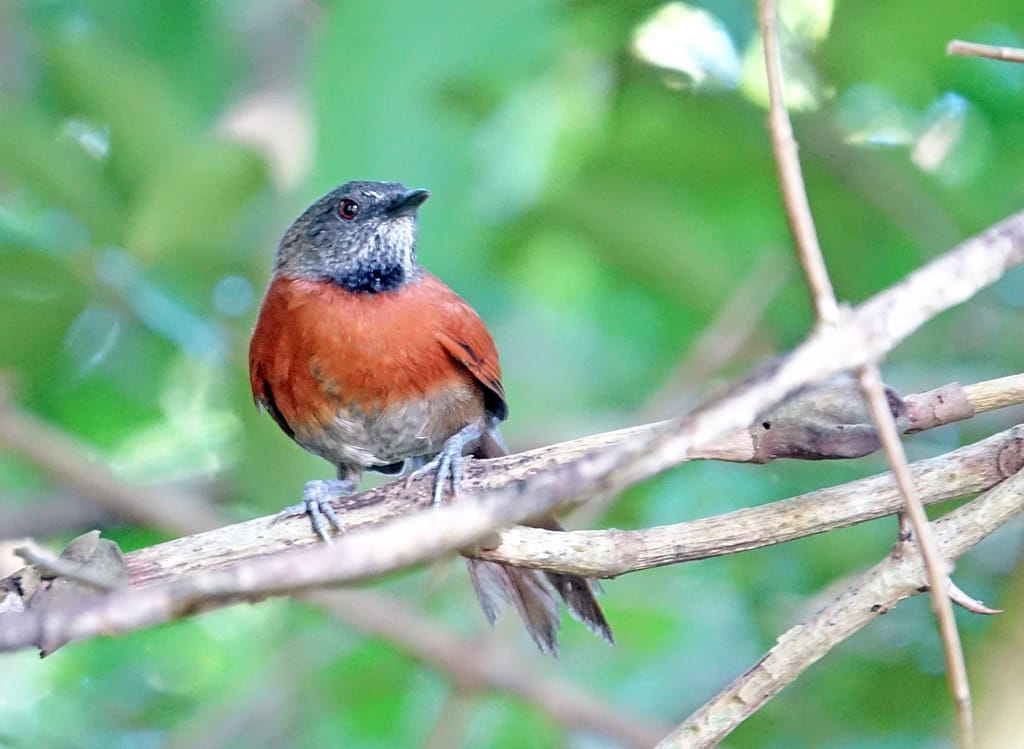
Rufous-breasted Spinetail – photograph by Sally Ingraham
Then we zoomed across Crooked Tree Village to the pine savannah to look for warblers and woodpeckers. The western causeway of the lagoon treated us to a Pinnated Bittern, which only Glenn’s skilled eyes could have spotted, and the sound of a Ruddy Crake.
Sunset that night was almost heart-stopping, and we couldn’t imagine a better day of birding (and had found just over 100 species!)
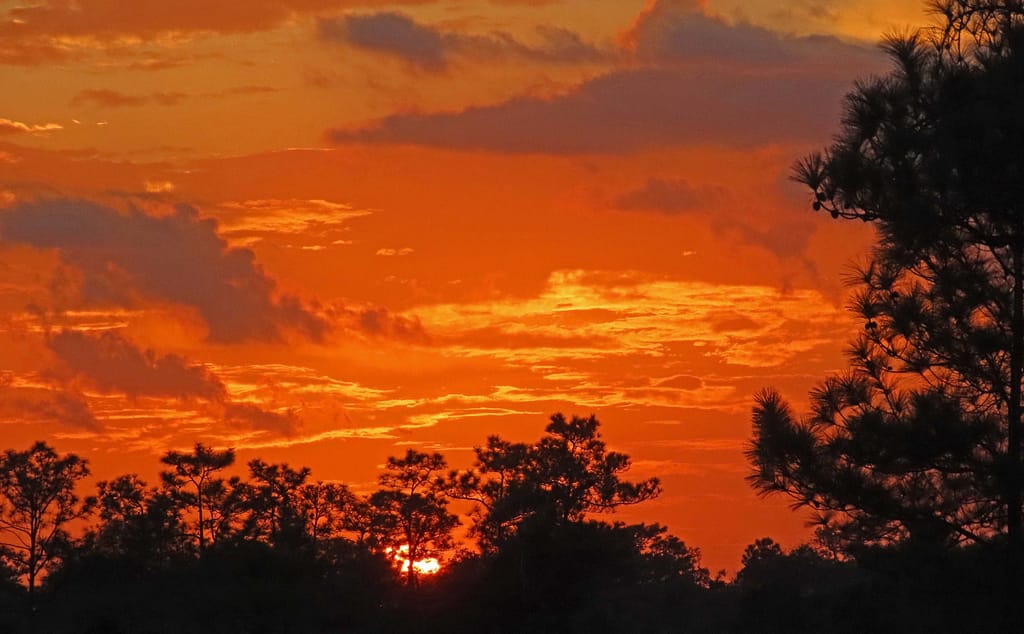
Sunset over the pine savannah of Crooked Tree – photograph by Mark Amershek
Lamanai Archaeological Reserve
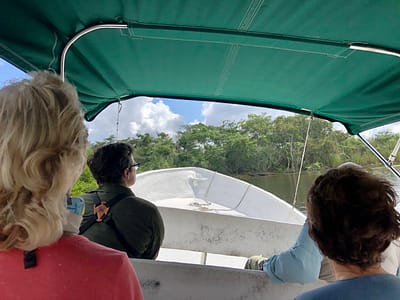
Headed up the New River – photograph by Sally Ingraham
There was more Crooked Tree birding to do, but we spent the better part of our last day in Belize visiting the Lamanai Mayan Ruins.
The 20 mile boat ride up the New River to the ruins was another highlight of the trip.
We traveled up the river at a good clip, but our skilled captain’s knowledge and Glenn’s sharp eyes would bring us to a sudden halt to see and photograph Lesser Nighthawks, Boat-billed Heron, Proboscis Bats, Sungrebe, and particularly cooperate Northern Jacana.
We were startled by quick looks at a “real” Muscovy Duck, and finally picked a Zone-tailed Hawk out of the numerous circling Turkey and Black and Lesser Yellow-headed Vultures.
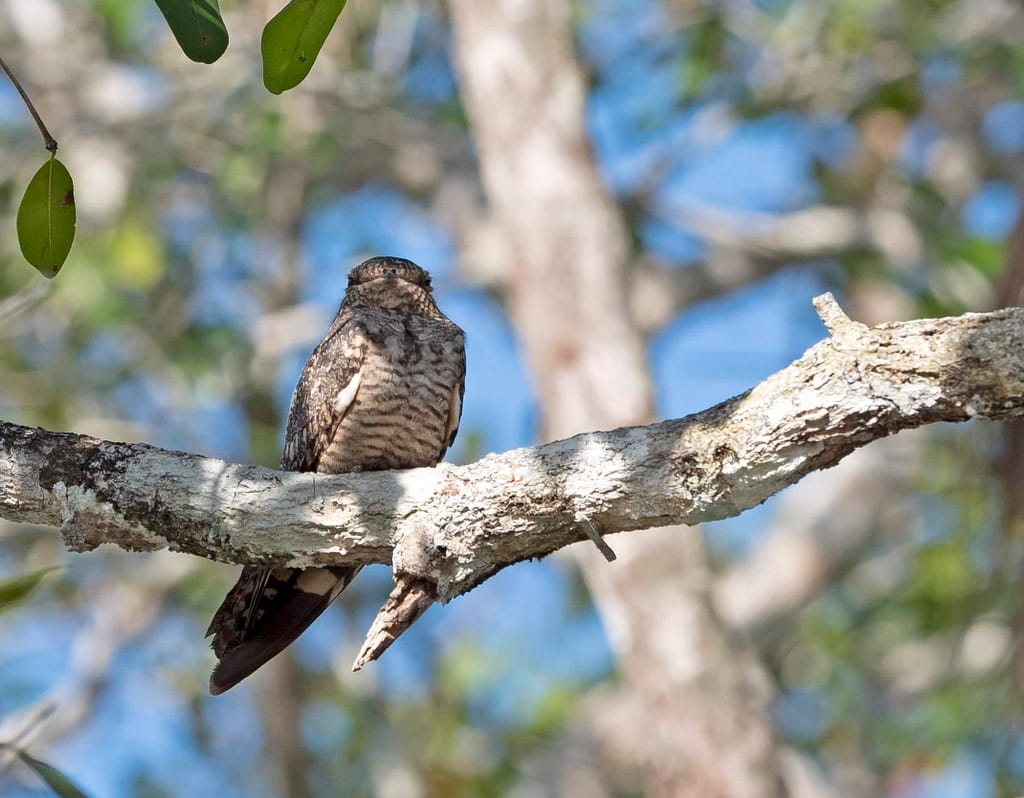
Lesser Nighthawk – photograph by Glenn Crawford, using the Olympus E-M1 Mark II
At Lamanai we went birding before visiting the ruins – or at least the Mayan ruins. Wandering among the remains of a sugar mill, we found Blue Ground Dove, Barred Antshrike, trogons and woodcreepers, Squirrel Cuckoo, and Black-headed Saltator. There were howler monkeys in the trees above, and another family of Pale-billed Woodpecker.
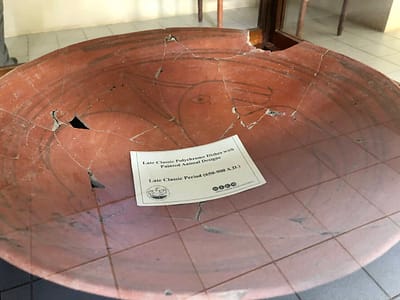
Perhaps a Royal Flycatcher adorns this Mayan plate – photograph by Sally Ingraham
We also found a Royal Flycatcher, although we were not treated to views of its hammerhead crest.
Later on, while exploring the Lamanai museum, tour participant Rebecca found a portrait of a flycatcher on a polychrome dish from the late classic period (650-900 A.D.) which seemed to bear a resemblance to our Royal sighting.
It is nice to think that there were “birdwatchers” in this area back then too!
We tried to turn our attention to the history of the Lamanai site as we walked among the impressive temples, and climbed to the top of one – but the birds continued to distract us.
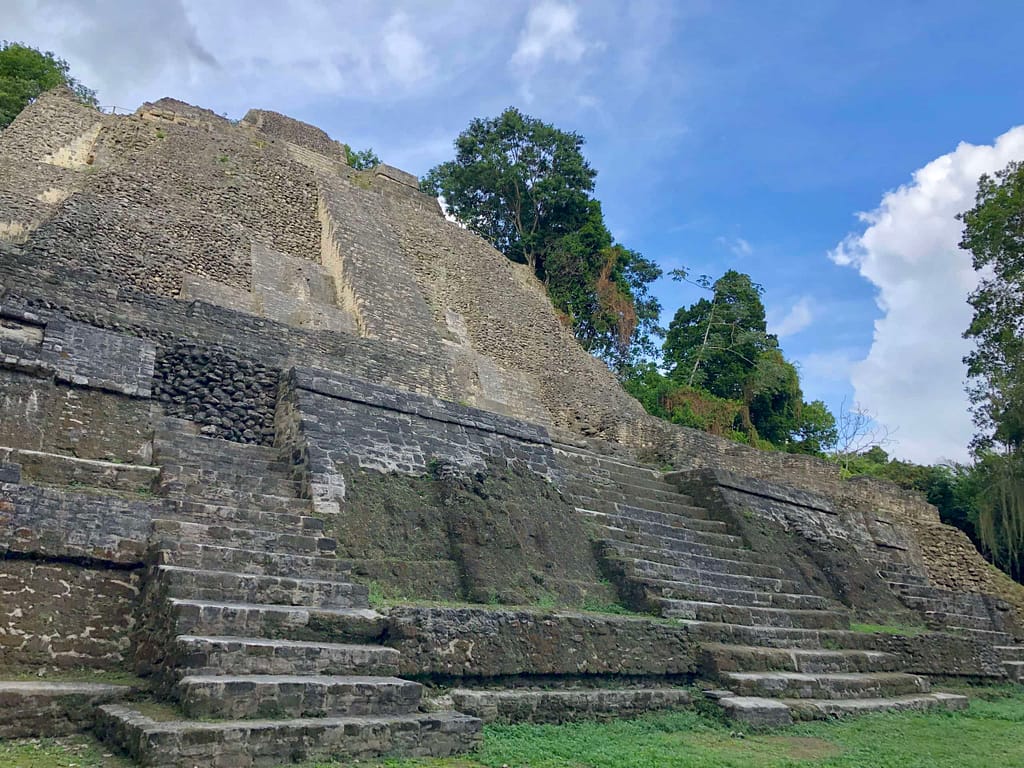
High Temple, at Lamanai – photograph by Sally Ingraham
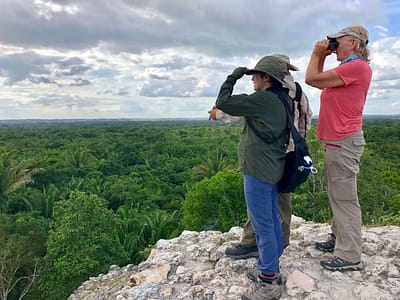
Birding from the top of High Temple – photograph by Sally Ingraham
There were Slaty-tailed Trogon and Rufous-tailed Jacamar, Chestnut-colored Woodpecker, Masked Tityra, and Stub-tailed Spadebill in the trees around the ruins.
From the top of High Temple, which a few of us climbed, we were above the canopy and watched Brown-hooded, Red-lored, and White-crowned Parrots fly past. Keel-billed Toucan settled in a tree below us, a Lineated Woodpecker worked on a nest hole, and Brown Jays patrolled.
Back on the ground, back through the forest, and back down the river we went.
It stormed on us as we came down the New River (the first and only time during the tour that we were caught in the relatively ubiquitous tropical rain).
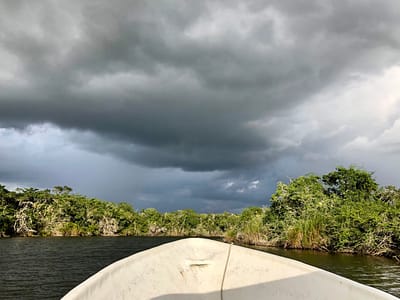
The New River between storms – photograph by Sally Ingraham
Despite this, the river was lined with herons and egrets – dozens of Yellow-crowned Night-Heron, Green, Great Blue – and finally, Agami!
In a lucky break between squalls, our much desired Agami Heron flew across the river in front of us, landing amid a tangle of roots on the opposite shore.
Although it kept mostly hidden, it stayed for long enough that we were all able to get satisfying glimpses of this stunning heron.
It certainly made up for the dampness and rounded out another phenomenal day (with almost 120 species seen)!
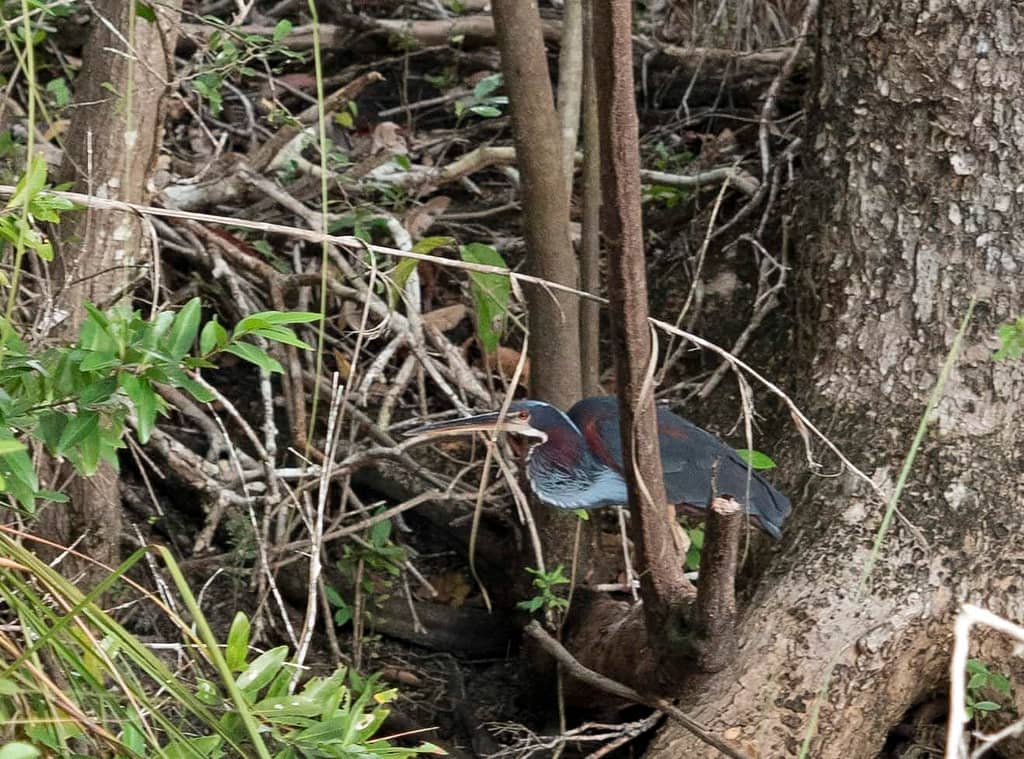
Agami Heron, photographed from a bouncing boat in the split second it was more-or-less in full view – photograph by Glenn Crawford, using the Olympus E-M1 Mark II
Crooked Tree Wildlife Sanctuary part 2
We birded around Crooked Tree every chance we got in those final days, cramming them full. We went on a pre-breakfast trip back to the pine savannah, before we went to Lamanai. This gifted us with Grace’s Warbler, Thick-billed Seed-Finch, Olive Sparrow, and Tropical Pewee among others.
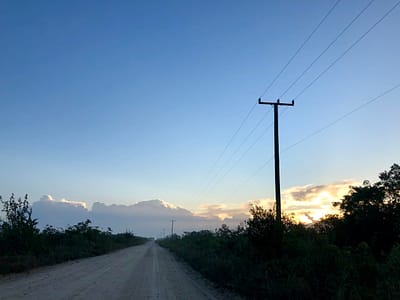
The road to Crooked Tree as the sun rises – photograph by Sally Ingraham
Our final morning Glenn had very specific birds he wanted to find for us, and packing had to wait until the last minute (not that anyone wanted to pack – or leave!)
A drive over the causeway and part way to the main road took us to new habitat. There we found Gray-crowned Yellowthroat, Rufous-browed Peppershrike, White-tailed Kite, and a flock of Black-throated Bobwhite.
It seemed unbelievable that this was the end – but of course, it was really just the beginning. Belize had exceeded all expectations.
Mark had found 11 new birds, despite his extensive travels in Central and South America. It was Rebecca’s first international birding trip, and she had made the acquaintance of (as she put it) 141 new birds. We all had made new people friends too, and plans were set for future trips or encounters in the US – and perhaps even in Belize again!
(After all, we had only birded in three districts – that left half of the country to explore yet, the southern forests, mountains, and coasts.)

The Wildside Nature Tours Belize December 2019 group – Mary, Mark, Glenn, Duffy, Donna, Rebecca, and me!
Rebecca, Duffy, and I had to leave earlier than the rest of the group. Later on, as Rebecca and I sat in the Houston airport (still traveling together, as fate had arranged) I got an excited text from Donna.
She and her sister Mary, with Mark, and Glenn to lead the way, had ventured into Belize City and found a Cinnamon Hummingbird – our 250th bird species of the trip! A perfect number – and bird – to conclude our Belizean adventure.
(All images in gallery below were taken by Glenn Crawford, using the Olympus E-M1 Mark II)





